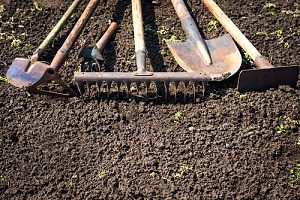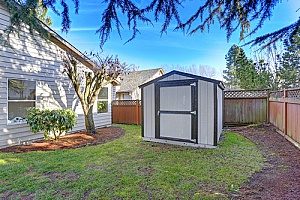 For just about every project you might be starting in your backyard, it is almost always necessary to have a level yard. For the majority of people, a level backyard is going to have to come from a little hard work and fill dirt. To level your backyard, you are going to be implementing a process known as land grading.
For just about every project you might be starting in your backyard, it is almost always necessary to have a level yard. For the majority of people, a level backyard is going to have to come from a little hard work and fill dirt. To level your backyard, you are going to be implementing a process known as land grading.
What Is Land Grading?
In terms of construction, land grading is a construction process in which land is leveled or sloped to form a base, typically called for when a foundation is needed for a building. Land grading can also be used to correct drainage problems, prevent flooding, level backyard space so the area is more useful, or terrace a property’s hillside yard.
The two types of dirt that most people choose for their projects are Virginia fill dirt and topsoil . Both have very different compositions and therefore have very different uses. Topsoil is essential for gardening or farming because this type of nutrient-rich dirt helps plants thrive. However, if fill dirt is used for a farming project, plants would have a very difficult time growing because fill dirt lacks the necessary nutrients.
Why Should Fill Dirt Be Used For Land Grading?
Fill dirt is primarily used for construction purposes such as building foundations or land grading. If topsoil is used for foundations or land grading, the project will not be successful because topsoil contains organic matter that breaks down over time.
This will result in the volume of the topsoil changing, which could then potentially cause any foundations on top to shift. This is also a problem when it comes to land grading because if you are trying to fill a low point, the low point may be initially filled to be level with the rest of the land, but over time the changing volume of the topsoil will result in the low point returning.
Why Should Topsoil Not Be Used For Land Grading?
 The presence of organic matter is also why you can not just use dirt from another part of your yard. You have no way of knowing whether that dirt contains organic matter or not, which means that you cannot guarantee its ability to create a permanent level grade to your yard.
The presence of organic matter is also why you can not just use dirt from another part of your yard. You have no way of knowing whether that dirt contains organic matter or not, which means that you cannot guarantee its ability to create a permanent level grade to your yard.
By getting fill dirt from a fill dirt contractor, you are getting dirt that has been screened and certified to ensure that it does not contain any organic matter, toxins, or large debris.
Using Fill Dirt To Level A Backyard
To begin leveling your yard, you need to determine the exact parameters of the area you are going to be leveling. This could be a relatively small piece of your land, or it could be your entire backyard. You will want to start by removing all grass, trees, and foliage from the area so they do not get in your way. Next, you want to mark out the parameters of the area you are going to be grading using stakes. Once the stakes are in place, you need to decide what height you are going to consider “level”.
Most of the time, it is easier to build up the ground than it is to have to dig and worry about removing dirt, especially because you are going to have to add dirt anyway. Find a spot within your parameters that you are going to build up the rest of the area to match and mark it with a stake.
Once you have decided what height you want to build up to, you want to use your fill dirt so that all areas within the parameters reach that height. Placing the fill dirt is relatively simple, you just have to pack down the dirt after to ensure that it will not move anywhere you do not want it to. You will probably want to add a little extra fill dirt to make it slightly higher because once you compact the dirt you will find suddenly that the area is just a smidge too low to reach your level point.
The Importance Of Leveling A Backyard With Fill Dirt
There are many different types of projects that will benefit from having a level backyard. In fact, having a level backyard can actually solve a lot of problems you may be experiencing. For example, if you are having drainage problems and experiencing a lot of rainwater flooding, land grading is exactly how you want to fix the problem. To fix this problem you have to find the high point and the low point of your drainage problem. The high point is where the water is flowing in the wrong direction.
For example, if the land slopes down in the direction of your house, the high point is going to be the very top of the slope. The low point is where the water is pooling, so it would be the very bottom of the slope. You need to place enough fill dirt in the low point to make it level with the high point. The fill dirt that has been placed will change the level of the slope and prevent water from pooling where you do not want it to.
 A level backyard is also essential for any project that is going to involve some building. Whether this is a shed, basketball court, or above ground pool, having a level yard is the first step to creating a sturdy foundation.
A level backyard is also essential for any project that is going to involve some building. Whether this is a shed, basketball court, or above ground pool, having a level yard is the first step to creating a sturdy foundation.
If you were to start any of those projects on an area of your backyard that has a slight slope, you are going to have a really hard time finishing a successful project because you will have to make some serious adjustments to compensate for the slope. This can even be true for a slope that is so slight you can hardly notice when just casually glancing at the area. It is extremely important to take the time before you begin any project to check and see if the land is level. If not, it is best not to cut any corners and properly adjust the slope so that you are starting your project off on the right foot.
Speak With A Virginia Fill Dirt Contractor
Experiencing difficulties with land grading or leveling your backyard? It is best to receive assistance from a professional fill dirt contractor who has experience leveling front, side and backyards as well as assisting homeowners with their construction projects. If performed incorrectly and without the help of a contractor, your yard may end up being uneven or suffering damages. Reach out to a residential land grading contractor at Dirt Connections for more information and to receive assistance with leveling your yard today.








































